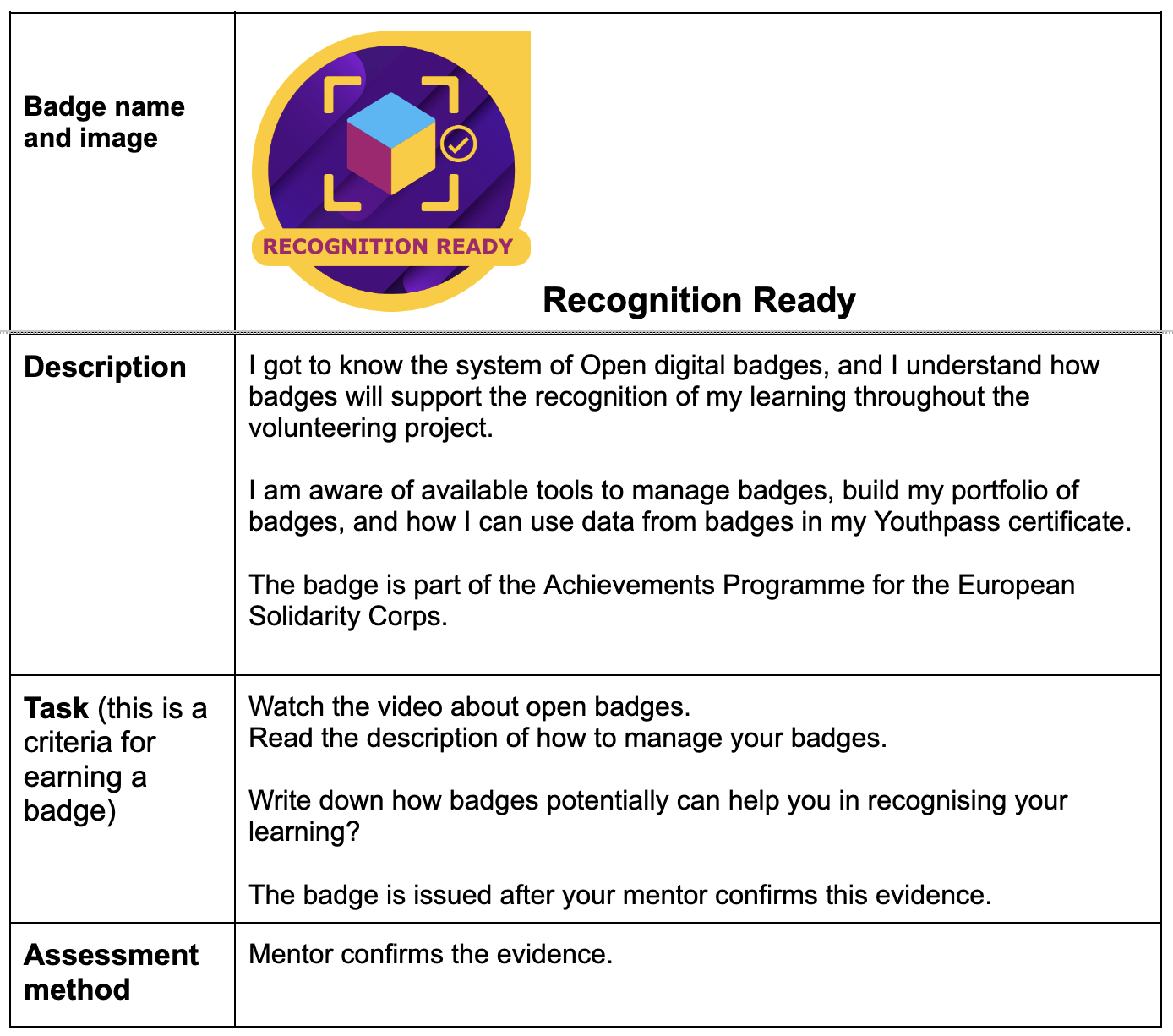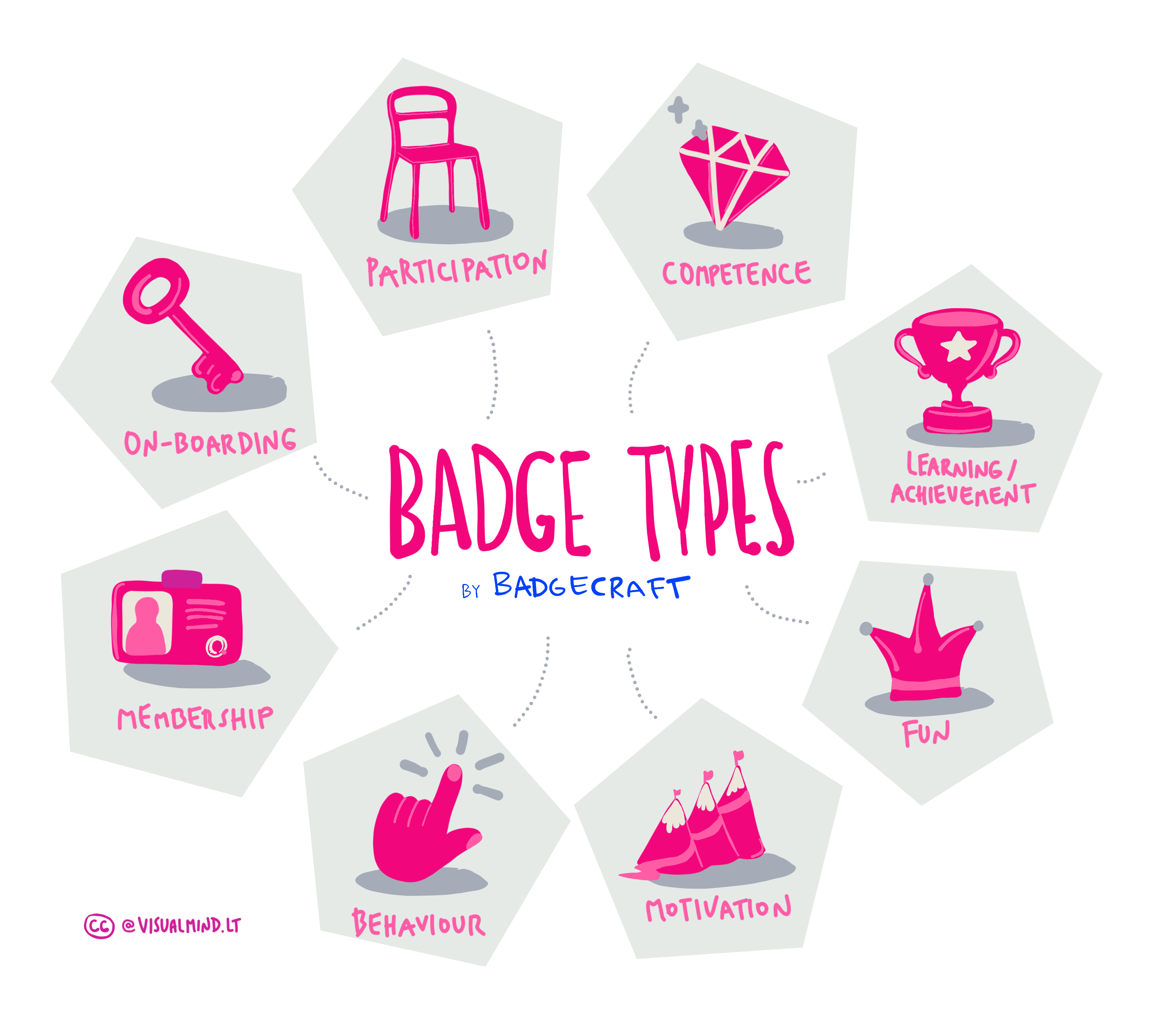5
Kreiranje kvalitetnih digitalnih bedževa i kreiranje sistema bedževa
Kreiranje kvalitetnih digitalnih bedževa i kreiranje sistema bedževa
Sadržaj
Ova lista učenja pružiće vam znanje i priliku da razvijete veštine u kreiranju kvalitetnih bedževa i sistema za priznavanje zasnovanih na bedževima.
Svaka aktivnost u ovoj listi je kao mali edukativni deo koji vam pomaže da bolje razumete osnove Open Badges sistema, kako da kreirate pojedinačni bedž i kako da ga integrišete u veći sistem bedževa.
Ako već kreirate bedževe i sisteme za priznavanje zasnovane na bedževima, možete jednostavno da postavite linkove ili snimke ekrana vaših kreiranih bedževa za svaku završenu aktivnost.
Lista sadrži 4 obavezne i jednu opcionu aktivnost, a završetkom dobijate bedž liste "Veštine za kreiranje kvalitetnih bedževa i sistema za bedževe":
Obavezne aktivnosti:
- Šta je Open Badge? Zanimljivosti o Open Badges.
- Kako započeti korišćenje Open Badges?
- Kako kreirati kvalitetan bedž?
- Kreiranje sistema bedževa i puteva učenja.
Opciona aktivnost:
5. Tutorijal za kreiranje bedževa.
Bedž liste je jedan od koraka za vašu organizaciju ka dobijanju "Oznake kvaliteta za prepoznavanje veština upotrebom digitalnih bedževa".
Oznaka kvaliteta označava posvećenost održavanju standarda kvaliteta u aktivnostima dodeljivanja bedževa. To je znak poverenja, kredibiliteta i priznanja za izdavače i korisnike bedževa, čime se podstiče zajednica posvećena pružanju kvalitetnog učenja i priznavanja veština.

Aktivnosti koje treba dovršiti
Obavite sledeće aktivnosti, steknite značke znanja i videćete da se napredak vaše plejliste ažurira
Sadržaj
Sada znate osnove o tome šta je Open Badge i čemu može da služi. Pogledajte ovaj video da biste naučili kako da kreirate dobar Open Badge.
Otvoreni digitalni bedževi beleže ključne informacije o učenju i postignućima smeštajući ove metapodatke unutar slike bedža. Ako su javno dostupni, ove informacije mogu da se pristupe i pregledaju od strane svakoga. Obratite posebnu pažnju na dva polja u informacijama o bedžu – opis i kriterijume za sticanje bedža.
Opis bedža pruža gledatelju bedža informacije o specifičnom učenju i postignuću koje bedž predstavlja.
Kada pripremate opis bedža, možete uključiti sledeće detalje:
- Kontekst postignuća. Gde i kada se desilo specifično učenje? Koje nove veštine, znanja ili promene su nastale kao rezultat učenja? Koje specifično postignuće je postignuto?
- Zadaci koji su završeni. Šta je korisnik bedža završio da bi kvalifikovao za ovaj bedž? Koje uloge ili aktivnosti je korisnik bedža obavio? Koji dokazi je korisnik bedža dostavio da bi potvrdio ovo postignuće?
- Procedure procene. Koje procedure procene su postojale da bi se proverili dokazi za bedž? Ko je bio uključen i kako je procena sprovedena?
- Otključavanje novih mogućnosti. Koje nove mogućnosti ovaj bedž otključava? Navedite sve vredne stvari koje ovaj bedž omogućava.
- Povezanost sa širim okvirom. Iako ove informacije mogu biti uključene kao posebno polje podataka u bedžu, nije na odmet da se spomene ako ovaj bedž prikazuje veštine koje su deo šireg okvira kompetencija ili obrazovnog standarda ili se povezuje sa određenim nivoom obrazovanja (pogledajte primer kako uskladiti bedževe sa DigiComp 2.1 okvirom). Kada dodate ove informacije, biće lakše proceniti prethodno učenje u odnosu na relevantni EQF nivo.
- Vreme provedeno za postizanje bedža. Ove informacije su važne jer daju informaciju o tome koliko je vremena bilo potrebno da bi se postigao ovaj bedž. Ako je osoba radila 3 sata ili 6 meseci da postigne bedž, to pravi razliku.
Saveti i preporuke za opis bedža
Evo nekoliko saveta koje treba razmotriti prilikom definisanja stila opisa bedža:
- Bedževi će biti pregledani od strane različitih publika: korisnici bedža, budući poslodavci, zaposleni u formalnom obrazovanju i drugi. Da li je određeni stil pisanja prihvatljiv za kontekst u kojem će se bedž koristiti ili pregledati?
- Zabavni opisi bedževa mogu motivisati učenike, ali mogu biti shvaćeni manje ozbiljno u formalnijim kontekstima. Dobro je testirati uzorke bedževa sa ciljanom publikom. Stil pisanja takođe zavisi od toga ko verifikuje postignuće i dokaze za bedž.
- Opis bedža može biti napisan u prvom licu ako su postignuće i dokazi samoprocenjeni od strane korisnika bedža. Ako bedževe izdaje osoblje, može se koristiti opis u trećem licu kako bi se prikazali postignuća korisnika.
- Pošto će bedževi biti prikazani na internetu, dobro je imati opis koji pruža dovoljno informacija da se postignuće i njegov kontekst razumeju.
- Metapodaci bedža su čitljivi za računare, što znači da se informacije o bedžu mogu otkriti pretraživačima i filtrirati u skladu s tim. Obratite pažnju na ključne reči koje mogu pomoći da se bedž lakše pronađe.
Kako opisati kriterijume za bedž?
Pored opisa bedža, kriterijumi su verovatno drugi najvažniji deo koji će pregledati osoba koja gleda bedž. Kriterijumi treba da budu vrlo jasni i za korisnika bedža i za spoljnog pregledaoca.
- Kriterijumi treba da postave specifične ciljeve za korisnika bedža – šta treba uraditi i šta treba postići. Kriterijumi treba da opišu koji dokazi treba da se dostave: tekst, slika ili neki drugi tip fajla.
- Tok procene – jasno treba da bude naznačeno kako će biti ocenjeni kriterijumi: da li od strane korisnika, od strane vršnjaka ili od strane edukatora ili menadžera programa.
- Potrudite se da kreirate kriterijume koji nisu previše kompleksni. Umesto toga, podelite složen bedž na više lakših bedževa koji se mogu postići.
- Neki bedževi možda neće zahtevati učitavanje dokaza, ali mogu zahtevati da se pre ovog bedža zarade drugi bedževi. To treba napomenuti u kriterijumima.
Molimo vas da pogledate nekoliko primera kvalitetnih opisa bedževa. Ovi bedževi su kreirani kako bi prepoznali učenje međunarodnih volontera u stranim zemljama.
U ovom primeru, možete primetiti da su autori sistema bedževa odlučili da koriste opis u prvom licu. Ovo je urađeno namerno, jer kada volonter deli svoj bedž, poruka dolazi iz perspektive vlasnika bedža.
Ovaj bedž služi kao uvodni bedž. To znači da ima za cilj da motiviše korisnike bedža da postanu zainteresovani i svesni šta su otvorni bedževi pre nego što osoba krene dublje u ceo program postizanja.
Vidite da je bedž prilično jednostavan u pogledu postignuća – postoji samo jedan zadatak i bedž se dobija završavanjem tog zadatka i odobravanjem dokaza od strane mentora.
Možete dodati specifične veštine iz vašeg odabranog okvira kompetencija kada postavljate svoj bedž na platformu Cities of Learning. Na taj način, povezaćete bedž sa širim kontekstom razvoja kompetencija.

Evo još jednog primera bedža, ali ovaj je mnogo složeniji – osoba može da osvoji ovaj bedž samo ako završi najmanje 2 od 3 zadatka, a dokazi budu odobreni od strane mentora.
Ovaj bedž je povezan sa jednim od ključnih kompetencija za celoživotno učenje – ličnom i socijalnom kompetencijom.

Vrste bedževa
Bedževi mogu biti dodeljeni iz različitih razloga i obično ih delimo na nekoliko vrsta. Tehnički, bedževi se ne razlikuju i prate isti standard. Međutim, kada se dizajnira sistem bedževa, dobro je sortiraće bedževe u različite tipove i biti svestan šta pokušavate da postignete sa svakim bedžem.

- On-boarding bedž može biti dodeljen osobama koje se upoznaju sa bedžovima i saznaju kako će se koristiti u određenom projektu ili događaju.
- Bedž za učešće prepoznaje ili motiviše aktivno učešće.
- Bedž za kompetenciju je često složeniji i može se sastojati od "manjih" bedževa koji prepoznaju znanje, veštine ili stavove.
- Bedž za učenje/postignuće se dodeljuje kao priznanje za specifično postignuće u učenju.
- Zabavni bedževi su često najpopularniji jer svi žele da se zabave, a ozbiljno zabavan proces učenja donosi dodatnu energiju i radost.
- Motivacioni bedževi možda neće prepoznavati konačna postignuća, ali mogu biti bedževi koji vode ljude putem, prepoznajući njihov trud, upornost i motivišući ih da nastave dalje.
- Bedževi za ponašanje mogu biti posvećeni prepoznavanju specifičnog ponašanja koje očekujete ili promovišete.
- Članske bedževe mogu simbolizovati pripadnost određenoj grupi, organizaciji, klasi ili procesu.
Kada istražujete primere sistema bedževa, primetićete da mnogi sistemi sadrže više vrsta bedževa. Sistem će početi sa nekoliko bedževa za uvođenje, zatim nastaviti sa bedževima za motivaciju i učešće, a potom sa više bedževa za učenje i postignuća. Kada dizajnirate sistem bedževa, možete označiti za sebe o kojem tipu bedža se radi i šta želite da postignete.
Ako ste željni da isprobate kreiranje digitalnog otvorenog bedža, možete to pokušati na www.awero.org.
Procena dokaza za bedž i načini izdavanja bedža
Možete odabrati nekoliko načina za izdavanje bedža. Identifikujte koji način je najbolji za vas, u zavisnosti od ciljeva vaše aktivnosti i bedža.
- Izdavanje bedža skeniranjem QR koda: Ova metoda izdavanja je automatski generisana od strane platforme (po defaultu). Ovaj način je naročito pogodan za događaje uživo, kada učesnici fizički dolaze na aktivnost i organizatori mogu odlučiti kada da izdaju bedž. Koristeći ovu metodu, učenici neće dodavati nikakve druge dokaze za bedž. Sam bedž biće dokaz o učešću.
- Izdavanje bedža putem e-maila: Ova metoda je pogodna ako ljudi ne mogu skenirati QR kod odmah ili ako su učestvovali u online aktivnosti, a organizator ima njihove e-mail adrese.
- Postavljanje zadataka za sticanje bedža: U mnogim slučajevima, logično je da bedž ne bude automatski dodeljen, već da ga učenik stekne nakon što završi određene zadatke. Izdavalac bedža može definisati jedan ili više zadataka za svaki bedž i zahtevati od učenika da postavi dokaze – bilo koji tip fajla: tekstualna refleksija, slika, link, itd.
Organizator može postaviti procenu na tri različita načina:
- Samo-procenjivanje: Dokaz se samopotrđuje prilikom postavljanja. Ovo je dobra metoda ako svoj obrazovni proces zasnivate na poverenju, proceni i samorefleksiji. Nije svaki proces učenja potrebno ocenjivati od strane eksternih lica.
- Procena od strane vršnjaka: Možete postaviti grupu vršnjaka iz iste aktivnosti koji moraju odobriti dokaz. Tek tada, bedž će biti dodeljen. Ova metoda je relevantna kada aktivnost uključuje više osoba koje zajednički rade na ostvarivanju nekih zadataka.
- Eksterno ocenivanje: Ova metoda je pogodna ako organizatori aktivnosti žele da vide dokaze i imaju ovlašćenje da ih pregledaju i odobre. Ovo je najviše "top-down" pristup i pogodan je za rigidnije obrazovne programe.

Resursi
- Download a Word version of a worksheet to create quality Open Badge(s)
- Download a PDF version of a worksheet to create quality Open Badge(s)
- Scarica il modello da compilare per descrivere i tuoi badge in italiano (Word)
- Scarica il modello da compilare per descrivere i tuoi badge in italiano (pdf)
- Scarica la checklist per valutare la qualità dei tuoi badge in italiano (Word)
- Scarica la checklist per valutare la qualità dei tuoi badge in italiano (pdf)
- Ženkliuko kokybės pasitikrinimo sąrašas_Lietuviškai (word)
- Ženkliuko kokybės pasitikrinimo sąrašas_Lietuviškai (PDF)
- Ženkliuko aprašymo šablonas
Preuzmi značku znanja aktivnosti
Kreator Kvalitetnog Bedža Preuzmi ovu značku znanja
Ovaj bedž pokazuje moju sposobnost da kreiram kvalitetne opise bedževa sa značenjskim zadacima i protokom procene.
Da bih stekao ovaj bedž, morao sam da pružim 1) opis jednog bedža prateći šablon, 2) kontrolnu listu kvaliteta bedža, i uzmem u obzir preporuke za kvalitetan opis bedža.
Ovaj bedž je dodeljen kao deo online kursa koji vodi ka sticanju Bedž Kvalitetnog Etiketa.
Zadaci
Zadatak broj1
Dokaz verifikovan od strane: jedan/na organizator/ka aktivnosti
Pogledajte opis vašeg Open Badge-a (iz prethodnog zadatka) i potvrdite da ste uključili sledeće podatke u opis bedža. Koristite kutije u dokumentu da dodate odgovore na pitanja sa liste za proveru. Ovo će vam pomoći da razvijete veštine analize opisa vašeg bedža i proverite da li ste uključili sve potrebne podatke.
Postavite popunjen šablon liste za proveru.
Aktivnosti: 4
Započeto: 184
Završena plejlista: 21
Vreme za završetak: 4 sati 20 minuta
Podelite :
Organizatori
Cities of Learning Network
Badge issuer recognized with
Badgecraft drži i razvija ovu platformu sa vodećim obrazovnim organizacijama. Program Evropske unije Erasmus+ odobrio je sufinansiranje za izradu prve verzije ove platforme. Kontaktirajte support@badgecraft.eu.
Platforma
Promenite na drugi jezik:

